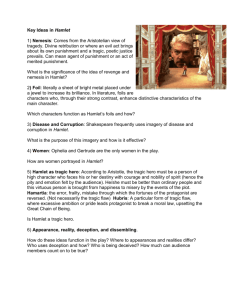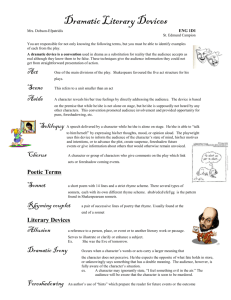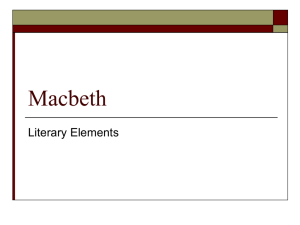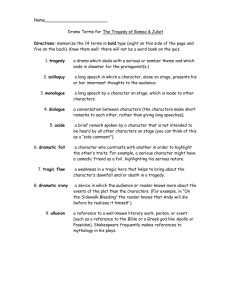Hamlet Ending
advertisement
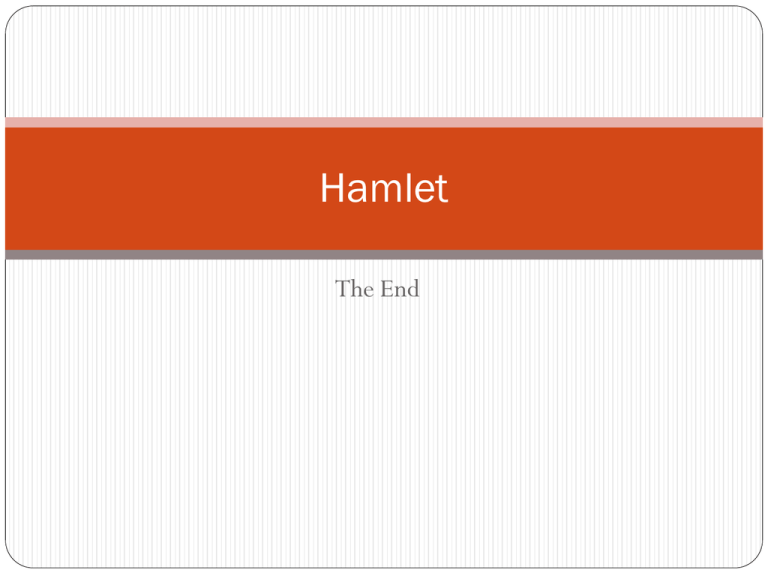
Hamlet The End Objectives: identify and discuss the characteristics of the play that mark it as a Shakespearean tragedy. as some of act 5 questions are answered, pick out and fill in the answers to act 5 questions, as your notes CE 3.2.3 Identify how elements of dramatic literature illuimiate the meaning of texts. Characteristics of a Shakespearean Tragedy Death for many characters Death for the tragic hero Hero exhibits a tragic flaw Order must be restored at the end Tragic Hero Aristotelian Model- a man who rose to a high position and then fell from that high position usually to utter desolation or death- depended on a tragic flaw as well as fate Renaissance Model- people felt themselves to be less pawns of fate and more in control of their own destinies Shakespearean Model- relies on responsible for downfall- “waste of human potential” Which category(ies) does Hamlet fall into? Typical Shakespearean Tragic Elements Tragedy is concerned primarily with one person – The tragic hero. The story is essentially one of exceptional suffering and calamity leading to the death of the hero- unexpected and contrasted with previous happiness and glory. The hero undergoes a sudden reversal of fortune. This reversal excites and conjures emotions of pity and fear within the audience. The tragic fate of the hero is often triggered by a tragic flaw in the hero’s character. The hero contributes in some way, shape, or form to the disaster in which he perishes. Typical Shakespearean Tragic Elements Shakespeare often introduces abnormal conditions of the mind (such as insanity, somnambulism, or hallucinations). Supernatural elements are often introduced as well. Much of the plot seems to hinge on “chance” or “accident”. Besides the outward conflict between individuals or groups of individuals, there is also an inner conflict(s) and torment(s) within the soul of the tragic hero. The tragic hero need not be an overwhelmingly “good” person, but, it is necessary that he/she should contain so much greatness that the audience cares about the character Contrast to Previous Happiness/Sudden Reversal of Fortune How does the entrance of Ophelia’s funeral procession continue the evolution to Hamlet’s understanding of death? Hamlet admits he loved her He realizes his previous perceptions of her were to happier times Death has become more personal for him What other event contributed to Hamlet’s misfortune? What significance do the skulls have? Emphasizes the end of physical life Physical decay follows death Anonymous skulls Yorick’s skull Leads to the emotional affect of Ophelia’s death on Hamlet Who died and why? Polonious- plot, characterization Ophelia- develop Hamlet’s understanding of death Rosencrantz and Guildenstern- irony Gertrude Claudius Laertes Hamlet Hamlet’s Greatness Hamlet is shown to be a nobleman when: he expresses sincere regret that he fought Laertes he recognizes Laertes has the same cause for vengeance and anger as him he approaches the duel as a sincere challenge He apologizes to Laertes- because he is a man with integrity The plan must end in bloodshed and death. Why? Order must be restored to the Kingdom of Denmark Fortinbras delivers the last line because in a Shakespearean Tragedy, the last one who speaks restores the shaken society. Review Characteristics of Shakespearean Tragedy??? Turn to the person next to you and share. Share with the class

